HNB406 Diploma in Business Assignment Sample
Module Code And Title : HNB406 – Diploma in Business Assignment Sample
1. Introduction
The aim of the report is to provide an overview on the theme of “How a major external event has transformed the workplace?” The report, therefore, will provide a roadmap for the path taken to design and undertake the research process to answer there above mentioned query. The external event considered for the review is that of the Covid 19 pandemic which has affected the United Kingdom and the rest of the world.
The company that I have chosen for review is that of Marks and Spencer. Initially this report will present an over view of the company and then detail the stages of this project development which would include aspects of project lifecycle, project management plan. The overall furnished plan and proposed timelines, etc will also be depicted using industry standard tools. As the report will show, the research method used for this project is based on primary data collection. Based on the analysis of the data, findings and inferences have also been provided.
2. Stages of Project life cycle and its importance
Project lifecycle refers to a series of phases that the project passes through from the start to the end. The five stages that every project passes through are: involve initiation, planning, executing, controlling/monitoring, and closing. The subsequent sections would explain each of the stages in the context of the project that we are undertaking which is to understand the degree of transformation in Marks and Spencer as a result of the Covid 19 pandemic and resulting changes in norms.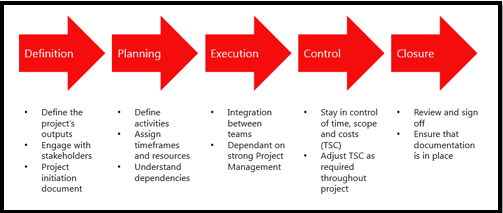
Project Initiation
In this stage of the project, the project aims and objectives are identified. The project deliverables are set and the key performance metrics for the project are decided upon. For this project, the needs of the company and the information requirements out the project were finalised. Then based on that, the aims and objectives of the project were also finalised. As noted in Jin, et al. (2019), in this stage of the project, it needs to be ensured that the proposed project including its “business case, project scope, objectives, deliverables, milestone plan and timeline, issues and risk, etc” align with the needs of the company.
Project Planning
It is in this stage that the structure and the strategy for the project is formulated. This requires consideration of various factors like access to resources and estimation of own capabilities. Time management, scheduling, work breakdown structures and delegating responsibilities are all done during this stage of the project. Risk assessment is also an important part of this stage based on which contingency planning is also done.
Project Execution
In this stage of the project, the actual work required for the project is undertaken. This stage requires specific adherence to the project plan and ensuring that everything goes accordingly. However, in case changes need to be made during the project, it also needs to be ensured that the proper contingency plans are followed and the key stakeholders of the project are let known as and when necessary.
Project Controlling
Project controlling and monitoring is the phase where the project before being handed over to the project owner, is tested and its performance monitored. For this project, the monitoring phase would estimation of whether the outcomes created from the research project matched the original requirements. If not that what more can be done to rectify the issue.
Project Closing
This is the last stage of the process where in the project deliverables are all completed and the outcome of the project is handed over to the project owner. This marks the end of the responsibility for the project manager having ensured that all the project deliverables are met.
B. Project Management Plan
1. Aim of the project
“To identify the degree of transformation that has been caused at Marks and Spencer as a result of the Covid 19 pandemic?”
The project aims to understand how the operations of the Marks and Spencer stores in UK have been transformed as a result of the Covid 19 pandemic and the regulatory restrictions put on stores as a result of this. The main scope of the research will be related to the employee perspective regarding their workplaces. The idea of transformation, what degree of transformation and the impact that transformation has had on the project will be researched in this project.
2. Objectives of the project
- To identify perception of the employees regarding the Covid 19 pandemic
- To identify the degree of transformation that the employees have perceived since the Covid 19 pandemic.
- To evaluate the impact of the transformation on the perceived well being of the employees.
- To extract meaningful inferences that could help in guiding the transformation process for the betterment of the employees at Marks and Spencer.
3. Scope of the Project
The scope of the project will include collecting information regarding the perception of the employees at Marks and Spencer towards the transformation at the work place. The scope of the project will include the collection of data., data analysis, delivery of meaningful inferences from the data in terms of recommendations, adherence to all relevant store policies and adherence to data privacy laws.
The scope of the project also includes the submission of initial plans for the project, providing information regarding the cost of the project and the schedule for the project. The mutual development of key project deliverables would be part of the project as well. Primary data collection from sources outside of the Marks and Spencer environment is not within the scope of the project.
4. Costs of the project
The costs for the project will be borne by the researcher themselves. All expenses incurred during the course of the project will be borne by the researcher. These include all aspects like transportation, data collection, communication, equipment, etc. In terms of costs, it will be the purview of the researcher to meet all necessary needs.
5. Time
For the successful completion of the project entirely, a timeframe of 8 weeks will be required. This timeframe includes the time for project planning, execution, monitoring and control until project completion. As noted in Kerzner and Kerzner (2017), the researcher will have to manage the limitations and constraints of the project like data collection, participation of respondents, delay, sickness and data analysis for this project. The time frame has been selected having considered all risks.
6. Quality
The key deliverables for quality for the project will be set up in the project initiation stage. This would include the nature of the report to be submitted, the quality of the data collected, the nature of the data analysis and the nature of inferences drawn. Additional supervision in terms of data analysis and information presentation will also be sought during the project. All attempts will be made to ensure that the data presented in the report is not mischaracterised, personal information is not put in the data as well as avoiding all forms of untoward manipulation of the responses.
7. Communication
For the communication plan of the project, the stakeholders for the project will be identified along with the information needs of each of the stakeholders. Information needs will include the communication channel, the content of the communication, the priority of the communication, schedule of information delivery, among other things. The following figure 2 depicts the role of the communication plan in the project lifecycle.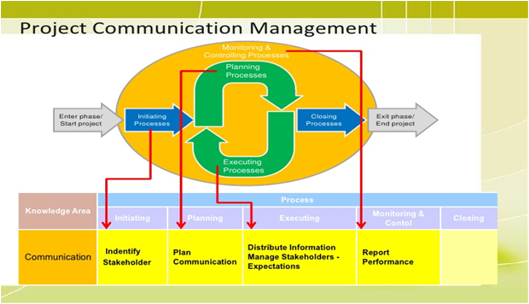
8. Risk
Risks assessment is a critical part of the project management plan. As noted in Susilowati et al. (2021), “the project management plan needs proper research to produce an inducive result that can be carried to justify the aspects of the project. A proper risk assessment plan needs to be taken into consideration.” The risk matric shown in Table 1 will be used to assess the risks identified in the project.
Table 1 Risk Matrix (1 is low and 5 is high)
The primary risks identified for the project are: time management, less than optimal participation form the employees, data loss, data privacy breach and mistakes in data analysis.
9. Work Break Down Structure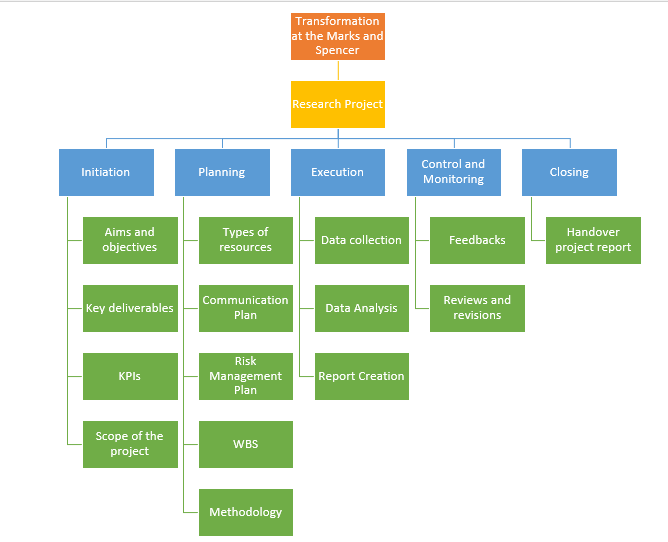
10. Gantt Chart
C. Conduct Primary and Secondary research
1. Research Methods
There are various methods available to research in an appropriate manner (Byrd, 2021). The research methods provide a detailed structure, plan, and process to conduct particular research. The research method includes all the tools, relevant literature, and references that have been used to conclude the final research. The research methods are important for the systematic completion of the research study. For this study, the literature survey was done through the use of secondary research.
The secondary research mainly included the collection of relevant academic journals form various repositories like Elsevier and Research Gate while also using search engines like Google Scholar. The studies identified through key word search were then manually sifted through (by reading through the extracts) to ensure that the relevance of the studies to the project could be ascertained.
For the primary data collection, on the other hand, survey questionnaires were used. The sample size included the stores of Mark and Spencer and the participants were the employees there in. All participants were explained the nature of the survey and how the data provided by them would be used. Consent was sought from all the participants. Questionnaires were developed based on the 5 point Likert scale and all the participants were sent Google forms where they could choose their responses to the questions. The data analysis was done as a percentage analysis based on the responses. The sample size for the research was 20. They were each sent a questionnaire with 10 questions.
2. Questionnaire
| Sl. No. | Question | Response |
| 1 | Are you satisfied with the level of hygiene related safety at your place of work? | Yes No |
| 2 | To what extent were you concerned about your health after the pandemic came to light? | 1 2 3 4 5 |
| 3 | During the early stages of the pandemic, to what extent were you apprehensive about coming to work? | 1 2 3 4 5 |
| 4 | How would you rate the company’s efforts in assuaging those apprehensions? | 1 2 3 4 5 |
| 5 | To what extent do you feel safe in your current environment? | 1 2 3 4 5 |
| 6 | To what degree do you think changes could be made further to make you feel safer? | 1 2 3 4 5 |
| 7 | How would you rate your mental wellbeing after the transformation of the workplace following Covid protocols? | 1 2 3 4 5 |
| 8 | How would you rate the management’s response to your apprehensions? | 1 2 3 4 5 |
| 9 | How would you rate your colleague’s behaviour during these times? | 1 2 3 4 5 |
| 10 | How would you rate your chances of continuing at this workplace? | 1 2 3 4 5 |
3. Data Analysis
Question 1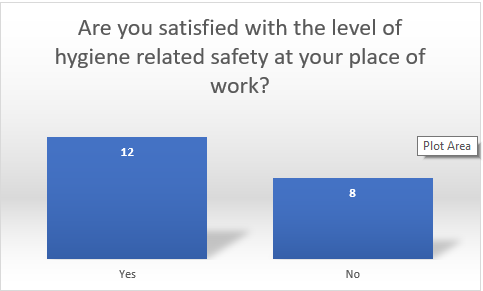
As can be seen from the responses, 60 percent of the respondents are currently satisfied with the degree of hygiene at the workplace currently. But in a sample size this small, a 40% minority is significant. The following questions will help in understanding these responses better.
Question 2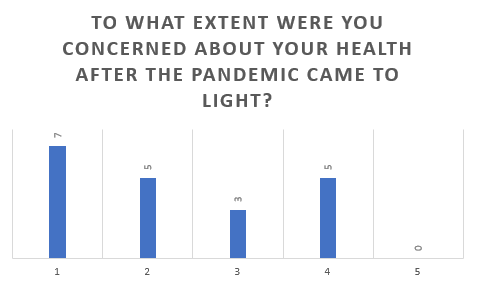
This suggests that at the initial stages a lot less of the people were concerned about the pandemic and its detrimental effects. In fact again 60% percent of the respondents claimed that they were either not worried at all or were very slightly worried. Combining this with the previous question, we can understand the degree of change in employee perception in this time frame.
Question 3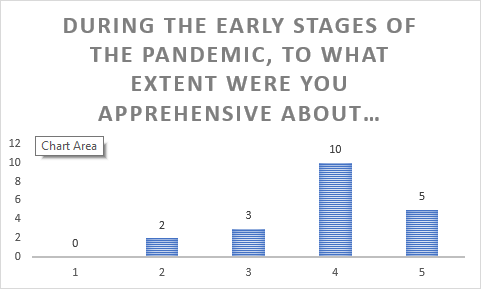
In this regard however, the people were more concerned with 75 per cent claiming they were either concerned or very concerned. This suggests while they were not concerned about the disease affecting them (as can be seen from pervious responses) however, they were worried about the disease being spread to their homes.
Question 4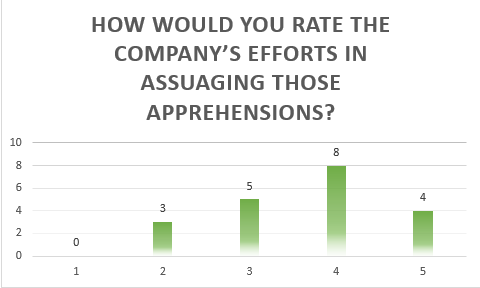
In this regard as well, most of the respondents submitted a positive response. Now looking at the responses to all the questions before, it can be suggested that the communication that was provided by the management was able to create an awareness about the issue and enabled them to be more prepared about safety at the workplace.
Question 5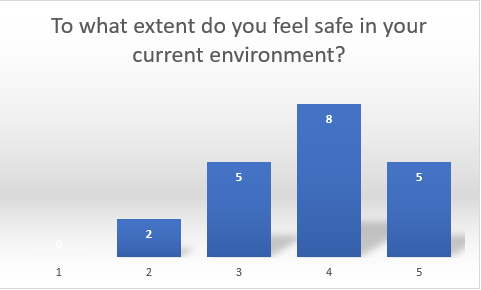
The responses to this question further illustrates how the employees currently view their work environment. Over 605 of the respondents claimed that they did feel safe or very safe in their ork environment.
Question 6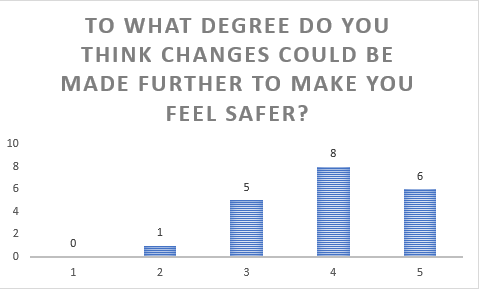
Here comes the scope for improvement as more and more people join the workforce. While they do feel safe in the work place, they do believe that more could be done to ensure greater degree of safety.
Question 7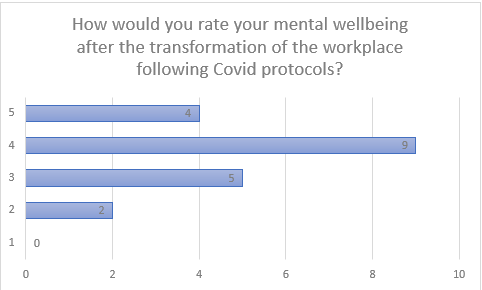
With regards to mental well being as well, it is clear that the individual employees, did perceive a high degree of attainment, however, it is to be noted that, as mentioned in the previous question, there is scope for improvement and additional transformation.
Question 8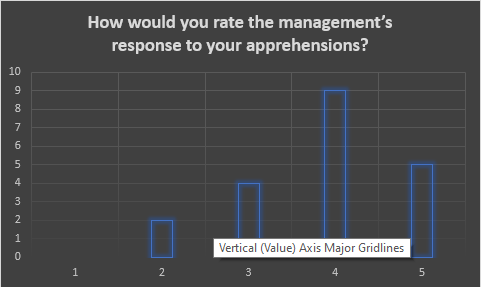
This question again was asked to ensure the effectiveness of the transformation process. The largely positive responses to this question shows that the employees were in fact satisfied with the way in the transformation was handled, however, they do believe that more needs to be done.
Question 9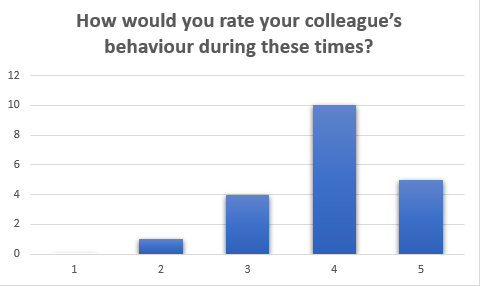
Peer group behaviour is another aspect that impacts the mental well being of the employees. IN this regard as well, most of the employees were happy about their peers’ behaviour. This suggests a culture of cooperation and mutual understanding in the work environment. In addition to that this also reflects as a success for the management’s ability to manage the transformation process during the pandemic.
Question 10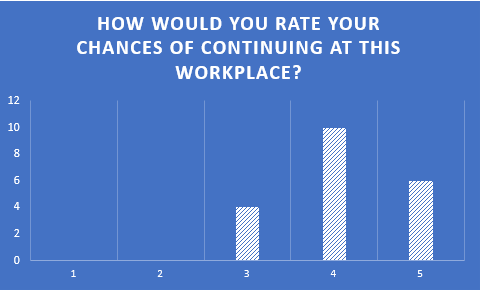
This question is designed to assess the over all outlook of the employees in the context of the transformation occurring as a result of the Covid 19 pandemic. The overwhelmingly positive response to this question suggests that despite the perceived need for some improvements, the employees are willing to continue in this work environment as they trust the fact that their management will be able to manage those changes well.
4. Conclusions and Recommendations
Based on the outcomes of the survey some points have come to light. At the initial stages the employees were not very apprehensive about the pandemic, however, based on inputs from the company management and other sources, they learned about the seriousness of the issue. However, based on the responses, it is certain that they have a positive perception of the transformation process undertaken by the management.
However, it is also to be noted that a majority do think that there is still a need for greater transformation with regards to the Covid appropriate protocols. Also, important to note is the fact that most did find their peers supportive as well which speaks to the management at Marks and Spencer.
Based on the analysis, the recommendations for the management would be:
- There needs to be a continuation of the existing communication plan regarding the transformation process with the employees.
- Surveys should be conducted internally to specifically highlight the nature of changes that the employees expect.
D. Reflective Practice
Undertaking the project of accomplishing the research was a significant step for me in the learning process. This allowed me several new experiences which helped me gain practically applicable insights into the field. First, the process of project management was a great learning experience as it allowed me a more structured way to envision the project while taking into consideration the various risks and limitations.
It also helped me to plan and execute the research process in the due time. Next, the research process itself was a revelation in itself as it tested various aspects of my academic learning. In addition to the personal growth, I also improved my ability to communicate with my peers regarding a specific goal. This has helped me learn how to make my communication more concise and relevant in a work setting and build good interpersonal relationships.
As a result of the study of the process, the research was developed to apply the adjustments as well as development to promote workplace diversity. These studies are carried out to determine the efficiency with which the transition may be implemented. It is necessary to acquire research information in order to perform the approaches efficiently in order to apply that effectively. It also helps to connect the company’s transformation over the years because it supports the ideas and outcomes.
The fundamental investigation aids in comprehending the manager’s viewpoint. Employees, in their opinion, always support a motivating and successful workplace since it allows them to grow and expand their knowledge base. Because it clearly outlines the project’s progress and objective, the study used here is the greatest way to comprehend the impact of the transformation.
The company’s transformation project aims to improve workplace transformation process and the impact it has had from the employee perspective. After conducting primary and secondary research, the results were analysed which suggested that while the employees were happy with the degree of transformation and the nature of it, they did believe that there are further things that the company could change in order to improve the situation more.
References
Al-Hajj, A., 2018. The Impact of Project Management Implementation on the Successful Completion of Projects in Construction. International Journal of Innovation, Management and Technology, 2(3), pp.21-27, 10.18178/ijimt.2018.9.1.781
Castellano, W.G., 2013. Practices for engaging the 21st century workforce: Challenges of talent management in a changing workplace. FT Press.
Kerzner, H. and Kerzner, H.R., 2017. Project management: a systems approach to planning, scheduling, and controlling. John Wiley & Sons.
Khan, A., Khan, S., Zia-Ul-Islam, S. and Khan, M., 2017. Communication Skills of a Teacher and Its Role in the Development of the Students’ Academic Success. Journal of Education and Practice, 8(1), pp.18-21. https://www.acpjournals.org/doi/full/10.7326/M20-1376?journalCode=aim
McClory, S., Read, M. and Labib, A., 2017. Conceptualising the lessons-learned process in project management: Towards a triple-loop learning framework. International Journal of Project Management, 35(7), pp.1322-1335. https://researchportal.port.ac.uk/portal/files/7482078/Conceptualising_the_Lessons_Lea rned_Process_In_Project_Management_postprint.pdf
Skeldon, P., 2021. Asda turns to AI as it accelerates multi-channel transformation strategy driven by return to UK ownership. [online] Internet retailing. Available at:
Susilowati, M., Kurniawan, Y., Prasetiya, H., Beatrix, R., Dewa, W. and Ahsan, M., 2021. How to manage scope, time and cost of project management plan to develop manufacture information system. IOP Conference Series: Materials Science and Engineering, 1098(6), p.062006, https://iopscience.iop.org/article/10.1088/1757- 899X/1098/6/062006/pdf
Ziek, P. and Anderson, J.D., 2015. Communication, dialogue and project management. International Journal of Managing Projects in Business, 8(4), pp.788-803.
Know more about UniqueSubmission’s other writing services:


I don’t think the title of your article matches the content lol. Just kidding, mainly because I had some doubts after reading the article.